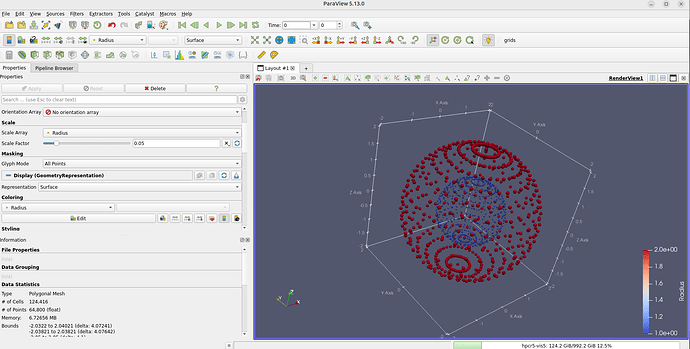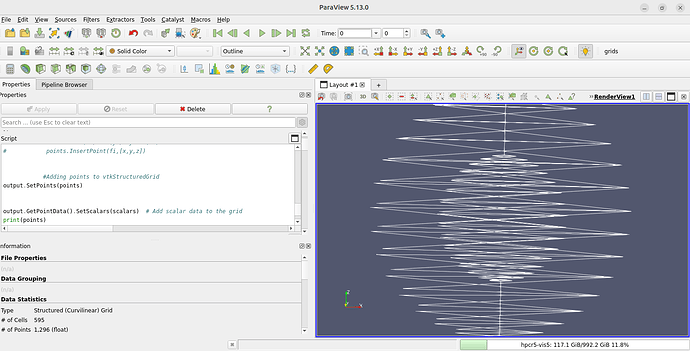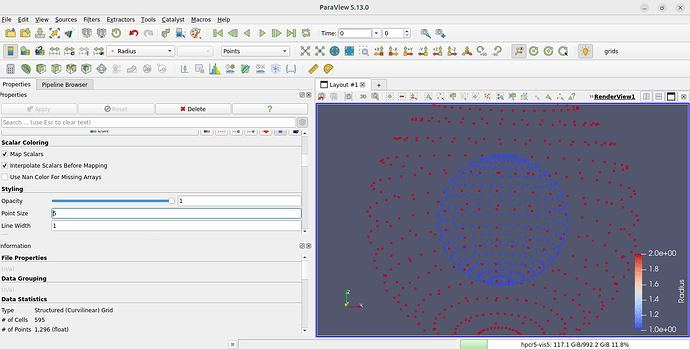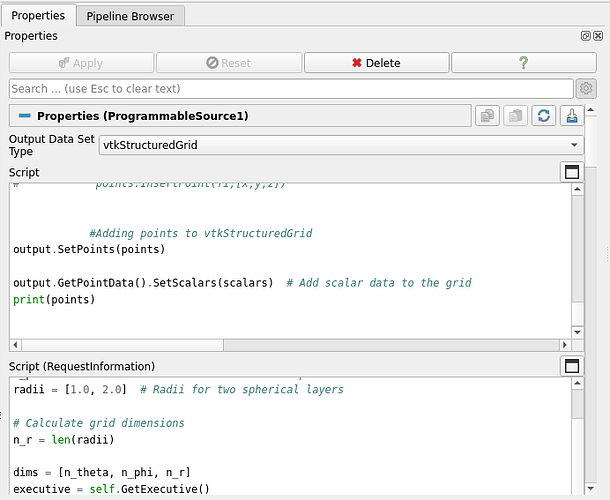Mathieu,
Oh boy. I just found out there was a second script window (RequestInformation) that
was completely hidden below the Information View !
Now that I split the code in two parts:
Script:
import numpy as np
from vtkmodules.vtkCommonCore import vtkPoints, vtkDoubleArray
from vtkmodules.vtkCommonDataModel import vtkStructuredGrid
# Parameters
n_theta = 18 # Number of divisions in the theta direction
n_phi = 36 # Number of divisions in the phi direction
radii = [1.0, 2.0] # Radii for two spherical layers
# Calculate grid dimensions
n_r = len(radii)
executive = self.GetExecutive()
outInfo = executive.GetOutputInformation(0)
exts = [executive.UPDATE_EXTENT().Get(outInfo, i) for i in range(6)]
dims=[exts[1]+1, exts[3]+1, exts[5]+1]
output.SetExtent(exts)
#vtk points
points = vtk.vtkPoints()
points.Allocate(dims[0] * dims[1] * dims[2])
scalars = vtkDoubleArray()
scalars.SetName("Radius") # Name of the scalar field
# Define spherical coordinates and convert them to Cartesian
for ir in range(n_r):
r=radii[ir]
for theta_idx in range(n_theta):
theta = theta_idx * np.pi / (n_theta - 1)
for phi_idx in range(n_phi):
phi = phi_idx * 2 * np.pi / (n_phi - 1)
x = r * np.sin(theta) * np.cos(phi)
y = r * np.sin(theta) * np.sin(phi)
z = r * np.cos(theta)
fi = ir*n_theta*n_phi+theta_idx*n_phi+phi_idx # Flat index
points.InsertPoint(fi,[x,y,z])
print(fi)
# points.InsertNextPoint(x, y, z)
# Add the scalar value (e.g., radius here)
scalars.InsertNextValue(r)
#Adding grid points #for iz, z in enumerate(zs):
# for iy, y in enumerate(ys):
# for ix, x in enumerate(xs):
# fi = iz*len(xs)*len(ys)+iy*len(xs)+ix # Flat index
# points.InsertPoint(fi,[x,y,z])
#Adding points to vtkStructuredGrid
output.SetPoints(points)
output.GetPointData().SetScalars(scalars) # Add scalar data to the grid
print(points)
Script(RequestInformation):
# Parameters
n_theta = 18 # Number of divisions in the theta direction
n_phi = 36 # Number of divisions in the phi direction
radii = [1.0, 2.0] # Radii for two spherical layers
# Calculate grid dimensions
n_r = len(radii)
dims = [n_theta, n_phi, n_r]
executive = self.GetExecutive()
outInfo = executive.GetOutputInformation(0)
outInfo.Set(executive.WHOLE_EXTENT(), 0, dims[0]-1 , 0, dims[1]-1 , 0, dims[2]-1)
I get the Outline representation immediately !
This will take some time to get used to.
Is there a way to programmatically set the Representation (to Points instead of Outline) , Coloring by scalar (“Radius”) and set the Point Size to say, 5 ?
To reuse the Source I suppose the next step would be to create a python plugin following Section 5.5 in
https://docs.paraview.org/en/latest/ReferenceManual/pythonProgrammableFilter.html#python-algorithm
?
Thanks,
JM




